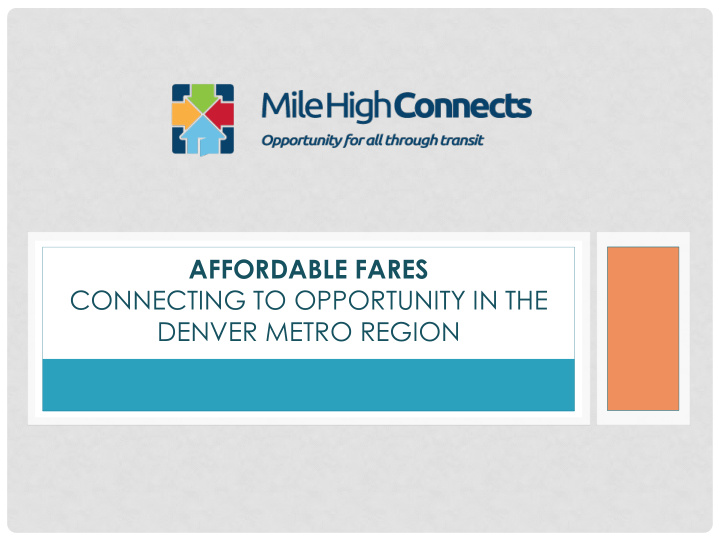



AFFORDABLE FARES CONNECTING TO OPPORTUNITY IN THE DENVER METRO REGION
THE IMPACT… •Nonprofits can’t meet financial On demand for individuals searching for jobs Community… • Inability to access healthcare/basic amenities • Higher turnover On employers… • Increase in tardiness & absenteeism • Reduced career readiness by prospective applicants • Spend more money & time traveling to/from work/appointments On individuals… • Reduced/limited access to healthy food options • Increased use of emergency services for routine medical care
AFFORDABLE FARE PROGRAM: GOALS Long Term Create a sustainable affordable fares program in which RTD offers persons earning150% of the FPL or less 50% discount on fares and passes (matching the discount currently offered to seniors, students and those with disabilities) Immediate Secure commitment from public and private sector partners to allocate $3.7 million annually for first 3 years of the program
POTENTIAL BENEFICIARIES ACROSS THE RTD DISTRICT 57,144 : RTD riders under 150% FPL that use transit at least “a few times a week,” who do not currently access non -profit, senior, student or disabled discount programs
AFFORDABLE FARES: WORK TO DATE Program Relationship Building : Administration Path Public Input • • Identified state and county RTD Board & staff • agencies on income Engaged state • verification • Explored technology based, agencies secure platforms Fundraising Path Identified government, quasi-government, and public • sector partners who have initiated budget allocation processes Engaged financial institutions in financing • conversations
AFFORDABLE FARES: PROPOSED IMPLEMENTATION Utilize HCPF’s existing transit infrastructure to support and scale the broader program. Creates a sustainable roll out plan. Provides context and understanding to the resources needed to scale the project. Allow for a timely implementation. Phase 1: Existing HCPF Transit Infrastructure Phase 2: Technology based secure government platform Phase 3: Broad Program Rollout
LOCAL FUNDRAISING PROGRESS ENGAGED Good Faith & Confirmed Commitments HCPF Denver Office of HIV Resources CHFA City and County of Denver Bank Partners DRCOG
WHERE DO WE GO FROM HERE Critical Milestones Ahead HCPF DRCOG Budget Funding Process Opportunities City/County Budget Process
WHERE DO WE GO FROM HERE Outstanding Questions • How can our work be best used by the pass program working group? • What is the best strategy to leverage commitments made by partners?
To learn more about this investment opportunity, please contact: Jeff Su jsu@denverfoundation.org Deya Zavala dzavala@denverfoundation.org
Recommend
More recommend